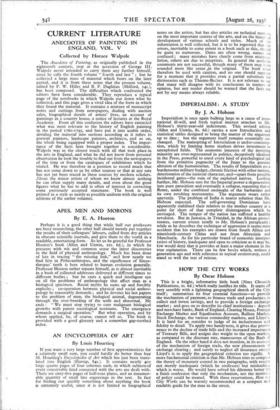This is a bright, informative little book (News Chronicle Publications,
2s. 6d.) which really justifies its title. It starts off very sensibly with a lightning geographical sketch of the City itself; summarises its four essential functions—to provide the mechanism of payment, to finance trade and production, to collect and invest savings, and to provide a foreign exchange market ; and goes on to describe its chief institutions : deposit and merchant banks, Bank of England, Clearing House, Foreign Exchange Market and Equalisation Account, Bullion Market, Stock Exchange, the various commodity markets, and Lloyd's. It is hard for an outsider to judge of its inclusiveness and fidelity to detail. To apply two handy tests, it gives due promi- nence to the decline of trade bills and the increased importance of Treasury Bills, and assigns due weight to the open market, as compared to the discount rate, manoeuvres of the Bank of England. On the other hand it does not mention, in its account of the mechanism of foreign trade, the new phenomenon of exchange clearing ; and surely to neglect all insurance except Lloyd's is to apply the geographical criterion too rigidly. A more fundamental criticism is that Mr. Hobson tries to compass the theory of monetary control in two paragraphs, with results not merely inadequate (which he confesses) but misleading, which is worse. He would have solved his dilemma better by a frank confession that only the mechanism, not the motive-, of policy could be treated. With these reservations, How tiro City Works can be warmly recommended as a compact and readable guide for the man in the street.


































 Previous page
Previous page